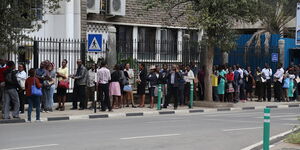Kenya Power has admitted that it is currently facing its biggest challenge yet as more Kenyans switch to solar power.
In its latest Annual Report, the electricity supplier, which is considered a monopoly in power distribution, revealed that the move by industries to adopt solar power impacted their bottom line in the last year.
According to the report, industrial customers account for 54.8% of its sales revenue.
"The company operated in a challenging environment over the financial year under review, where demand growth at 3.7% remained below the projected level of 5%.
"The dampened demand growth is further compounded with the increased threat of grid defection by the industrial category as decentralized renewable energy options are becoming more available and cheaper," reads an excerpt from the report.
The mass migration to solar power comes at a time when the state entity is grappling with huge volumes of idle electricity.
Several companies and factories have made the switch to solar grid systems in a bid to reduce operational costs.
In the year ended June 2019, Kenya Power received Ksh63 billion from industrial customers who consumed 4,462 Gigawatt hours, accounting for 45% of its total revenue.
From Moi International Airport in Mombasa setting up a 500 KW solar PV system to new malls such as Garden City installing a solar carport thay generates 1,256 megawatt hours each year, more and more organizations are opting to go the solar way.
Official data released last year revealed that 2.3 million households also used solar for lighting.
In the wake of its biggest threat, Kenya Power announced that strategies were already in place to assist in pushing up demand growth through incentives like the electricity cost rebate program, time of use tariff and pre-investment schemes.
Further, the electricity supplier has embarked on a turnaround strategy that it expects to lift it out of losses with a focus on cost-cutting.
Kenya Power said it has already reduced its corporate budget and is evaluating other areas to cut including staff costs.
“As we go forward, we are focusing on implementation of a recovery strategy that focuses on growing electricity sales, enhancing revenue collection, managing costs and improving system efficiency,” said Managing Director Bernard Ngugi.
He added that the firm had since July this year connected 140,000 new customers against a target of 125,000 despite the Covid-19 pandemic.
The state utility is also seeking a tariff hike in a bid to increase revenues, which the CEO said they would continue pushing for.
The new structure, if the firm has its way, might see low-income households pay more for power.
Currently, households consuming less than 100 units of electricity per month pay Ksh10 per unit.
In December 2018, President Uhuru Kenyatta announced plans to move the country to 100% green energy by 2020.
Kenya is among the few countries in Africa that have experienced the highest growth in solar instalments, according to a report released recently by the United Nations Environment Programme and the Technical University of Denmark (UNEP-DTU) partnership.
Rapidly falling global solar PV prices, increasing energy demand and available financing have enabled the rapid growth trend in Kenya.












